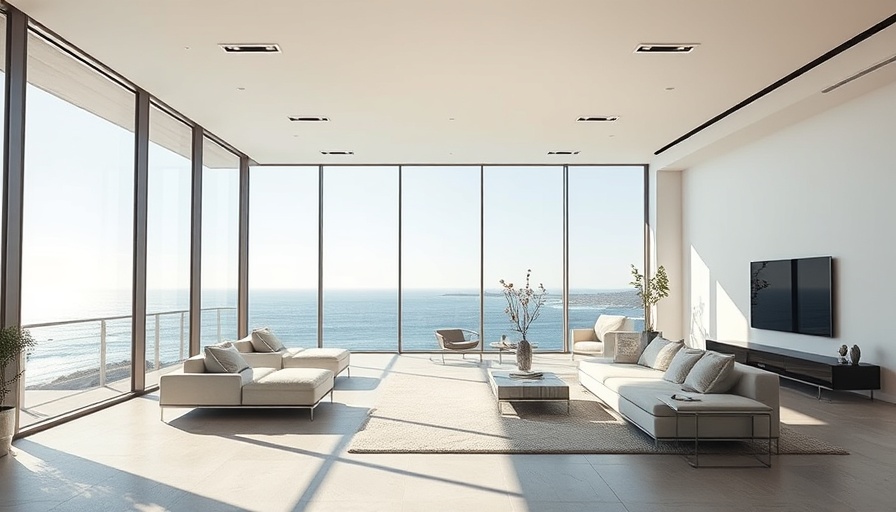
Unveiling the Allure of Coastal Living: A Comprehensive Look at the Ravine House
When dreams and design meet the horizon, magic happens. Nestled along the stunning Australian coastline, the Ravine House stands as a testament to architectural innovation inspired by nature. This magnificent abode isn't just a house; it's an experience—where the beauty of ocean views meets the artistry of design in an extraordinary way.
In 'Inside Dream Home With Jaw-Dropping Ocean Views', the discussion dives into stunning architectural designs, inspiring us to explore the alluring features of the Ravine House and the beauty of coastal living.
Architectural Brilliance: The X-Shaped Plan
The design of the Ravine House is strikingly unique, featuring an X-shaped plan that takes full advantage of its cliffside location. This architectural choice not only maximizes the breathtaking views but also creates intriguing vignettes throughout the home. Rather than revealing the entire coastline at once, guests are welcomed into a slow reveal of nature’s beauty, enhancing the emotional impact of the surroundings.
Using durable materials like high-density concrete and low E-glass, the structure withstands harsh marine environments while showcasing elegance. The architectural genius lies in its ability to draw people in, encouraging them to explore every corner and bask in the sunlight filtering through carefully placed skylights.
Functional Spaces Designed for Entertainment
Inside, the Ravine House is a haven for social gatherings. The kitchen, fitted with sleek black quartzite countertops and a unique downdraft exhaust system, becomes a focal point for entertainment. The open-plan design ensures that whether you’re cooking or mingling, the views remain an integral part of the experience.
At the heart of the home lies a beautiful outdoor entertaining area, offering a seamless transition from indoor luxury to outdoor tranquility. This design philosophy resonates well for anyone looking to capture the Mediterranean experience within their own backyard.
Bringing Mediterranean Vibes Home
Inspired by the Mediterranean gardens, Ravine House’s design emphasizes outdoor spaces where family and friends can gather. Think of olive trees basking in the sun, flowering herbs enriching the senses, and vibrant potted plants that heighten the aesthetic. These elements don't just beautify the surroundings; they cultivate a relaxing atmosphere where one can unwind while enjoying the landscape.
For those looking to recreate this Mediterranean charm at home, consider investing in drought-tolerant plants that require minimal upkeep. A beautiful herb garden with rosemary, thyme, and lemon will add not only to the visual beauty but also be a cooking delight right from your patio.
Embracing Sustainable Practices
The Ravine House philosophy extends beyond architecture; it heralds sustainable living. Homeowners can learn invaluable lessons from this property, particularly on ways to reduce energy consumption through smart home solutions. Simple interventions like sealing drafts, installing energy-efficient windows, and engaging in organic gardening practices can significantly decrease both environmental impact and utility costs.
For someone starting their own gardening journey, understanding the power of composting, weeding techniques, and a well-thought-out irrigation system can transform outdoor spaces into thriving ecosystems. By incorporating local flora into your garden, you're helping the environment while ensuring that your green space reflects the natural beauty that inspired the Ravine House.
Contemplative Spaces: Art Meets Nature
A unique aspect of the Ravine House is its dedicated space for contemplation and art. This area serves as a reminder that homes should inspire creativity and relaxation. The reflection of light through the pool area further enhances the experience, bringing the feeling of being one with nature.
In our ever-busy lives, we often forget the significance of having spaces that promote mental wellness. Transforming a room or corner of your home into a sanctuary for reflection can introduce a sense of peace and well-being.
Conclusion: Making Your Dream Home a Reality
The exploration of the Ravine House highlights not only stunning architectural design but also the importance of harmoniously blending indoor and outdoor spaces. Emulating this coastal home can inspire homeowners to take charge of their living spaces by integrating efficient practices, beautiful landscapes, and spaces that reflect personal values.
As we dream about our ideal homes, let's take a lesson from the incredible design of the Ravine House. Embrace your surroundings, celebrate nature, and create a personal haven that resonates with beauty and sustainability.
 Add Row
Add Row  Add
Add 




Write A Comment